Discover 11 hidden attractions, cool sights, and unusual things to do in Cuyahoga Valley National Park (United States). Don't miss out on these must-see attractions: Blossom Music Center, Hale Farm and Village, and Cuyahoga Valley Scenic Railroad. Also, be sure to include Brecksville-Northfield High Level Bridge in your itinerary.
Below, you can find the list of the most amazing places you should visit in Cuyahoga Valley National Park (Ohio).
Table of Contents
Blossom Music Center
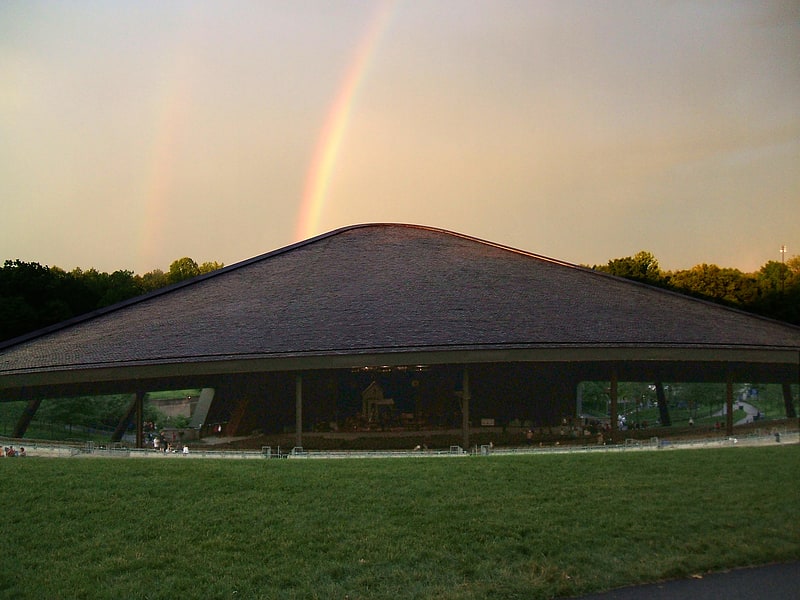
Amphitheatre in Cuyahoga Falls, Ohio. Blossom Music Center is an outdoor amphitheatre located in Cuyahoga Falls, Ohio. The venue is the summer home of The Cleveland Orchestra and site of the ensemble’s annual Blossom Festival. Blossom Music Center is owned by the Musical Arts Association, the Orchestra’s parent organization. The music center is named after the families of Dudley S. Blossom Sr. and Dudley S. Blossom Jr. The former had served as the president of the Musical Arts Association from 1936 to 1938, and his widow Elizabeth and daughter-in-law Emily continued to support the Musical Arts Association after Dudley Jr.’s death in 1961. The Board’s president, Frank E. Joseph, felt that the Blossom family was “more deserving of the honor than any other Cleveland family.” The pavilion is constructed of slate and tubular steel, and seats 6,051 people. Behind the pavilion is a general-admission lawn section, which can seat an additional 15,000 audience members. The venue is also host to a full summer schedule of popular music acts and symphonic performances. Blossom’s natural parabolic setting, the pavilion’s sloping slate roof, and the countryside’s wooded surroundings distinguish it from other contemporary amphitheaters.
For many years, members of The Cleveland Orchestra had struggled to gain year-round employment playing music. During the early 1950s, summer performances were held at Public Hall in downtown Cleveland and, on occasion, in the outfield of Cleveland Stadium before Indians’ games. In the mid-1960s, music director George Szell was driven to find employment for his musicians throughout the summer months. Beginning in 1965, the Musical Arts Association began to investigate possible sites on which to build the Orchestra’s new summer home. Szell had a clear vision in mind: “It is of course IMPERATIVE to have such an installation for the summer, it seems to me even more important to have it turn out to be exceptional, absolutely first rate, terribly attractive...”
In July 1966, the Musical Arts Association decided to purchase 571 acres of land near Cuyahoga Falls, Ohio, which is approximately 10 miles north of Akron and about 30 miles south of Cleveland. (Eventually, more land was acquired to bring the total amount owned by the Musical Arts Association to 800 acres.) By 1967, the Musical Arts Association would launch its “Half Century Campaign” to raise money for the construction of Blossom’s pavilion. The initial collaboration included Connecticut-based acoustician Christopher Jaffe and Cleveland architectural firm Shafer, Flynn and Van Dijk, which oversaw the modeling and building of the amphitheater. As construction proceeded, Jaffe was replaced by German recording engineer Heinrich Heilholz, whom Szell preferred. The fundraising campaign reached its goal of $6.6 million, and ground was broken on July 2, 1967. The Blossom Festival’s inaugural concert, featuring Beethoven’s Ninth Symphony conducted by Szell, took place on July 19, 1968, with a live television broadcast on WKYC-TV3. The following year the Orchestra hosted its first Fourth of July concert at Blossom — led by Meredith Wilson, who composed The Music Man.
In 2003, Blossom underwent a $17 million renovation intended to enhance a number of areas across the venue, including the sound system, stage, guest services, parking lots, and landscaping. In a transaction designed to give the Orchestra a financial boost and protect Blossom’s natural surroundings, the Musical Arts Association sold 580 acres of the site’s undeveloped land to the National Park Service in 2011.
Blossom is also widely used for popular music events, especially folk, rock, and country. The largest recorded show attendance at Blossom was for a Blood, Sweat and Tears concert in 1969, just one year after the venue's opening, totaling in 24,364. An unofficial estimate to a Pink Floyd concert in 1973 claims 32,000 were in attendance. The amphitheater has played host to many music festivals, Lollapalooza, Mayhem Festival, Ozzfest, and Vans Warped Tour. The Michael Stanley Band, intensely popular in Northeast Ohio, but virtually unknown elsewhere, set an attendance record, of 74,404, with four sold-out shows, on August 25–26 and 30–31, 1982. Rock artist James Taylor was the first artist to play double nights at the amphitheater in 1979, with a combined attendance of over 42,000.[1]
Address: Cuyahoga Valley National Park, 1145 W Steels Corners Rd.
Hale Farm and Village
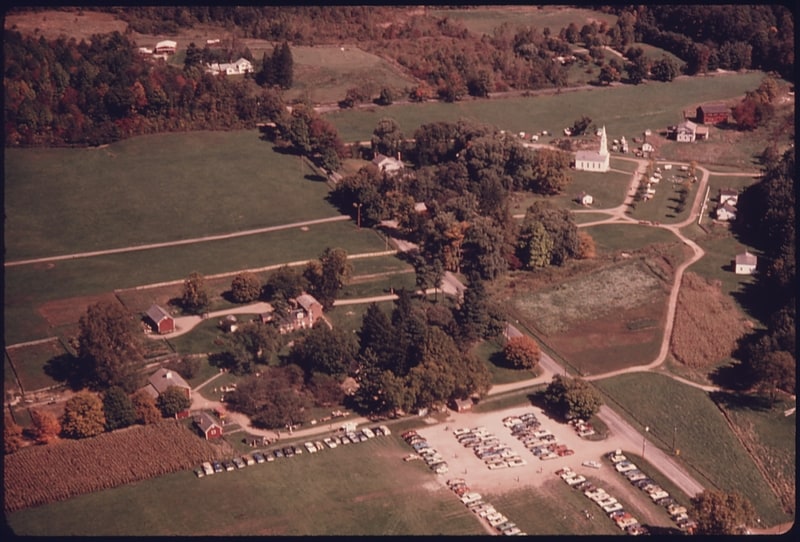
Museum in Summit County, Ohio. Hale Farm and Village is a historic property of the Western Reserve Historical Society in Bath Township, Summit County, Ohio, United States. It is within the boundaries of the Cuyahoga Valley National Park. Hale Farm was the original homestead of Jonathan Hale, a Connecticut farmer who migrated to the Western Reserve in 1810. In 1973 Hale Farm was listed on the National Register of Historic Places as the Jonathan Hale Homestead. The Hale House was built in 1825.[2]
Address: 2686 Oak Hill Rd, 44210 Bath
Cuyahoga Valley Scenic Railroad
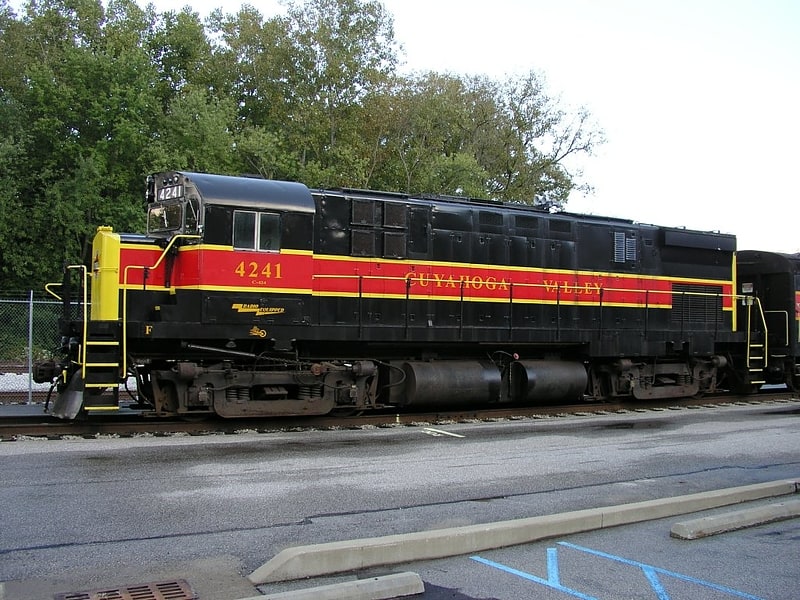
Cuyahoga Valley Scenic Railroad is a Class III railroad operating diesel-electric and steam-powered excursion trips through Peninsula, Ohio in the Cuyahoga Valley, primarily through the scenic Cuyahoga Valley National Park.[3]
Brecksville-Northfield High Level Bridge
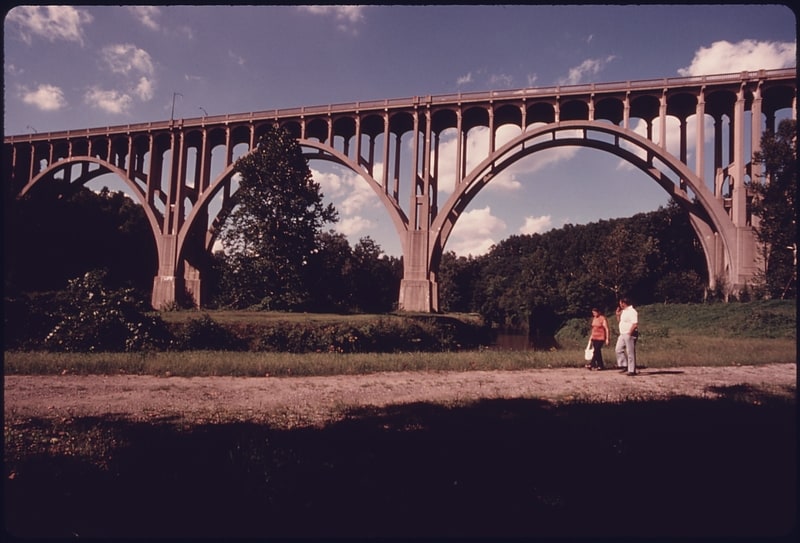
Arch bridge in Summit County, Ohio. The Brecksville-Northfield High Level Bridge is a bridge in Greater Cleveland, Ohio, U.S., connecting Brecksville in Cuyahoga County with Sagamore Hills Township in Summit County. It is located in the Cuyahoga Valley National Park.
In 2012, five men were arrested and accused of planning to blow up the bridge. The five were accused of planting what they thought were explosives and attempting to detonate it with a cell phone. Following guilty pleas and one conviction, the men were sentenced between November 2012 and October 2013.[4]
Bath Hollow Farm
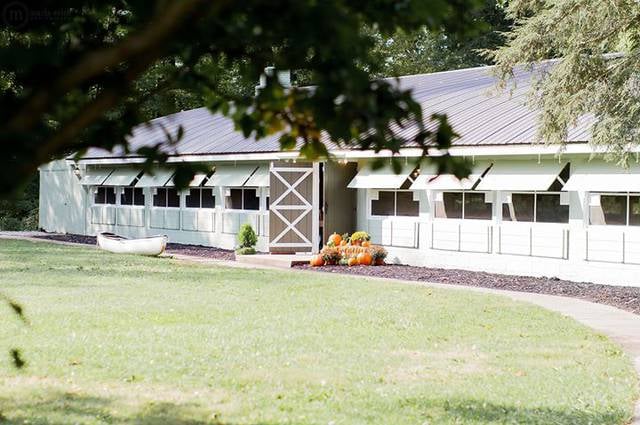
Park, Relax in park
Address: 1104 W Bath Rd, Cuyahoga Valley National Park
Indigo Lake

Lake in Ohio. Indigo Lake is a small, roughly triangular lake in Summit County, Ohio, in the United States. It is not a natural lake, having been created by the park service in Cuyahoga Valley National Park. It is a popular fishing location, with several species present including the Largemouth bass.[5]
Tinkers Creek Aqueduct

Navigable aqueduct in Valley View, Ohio. Tinkers Creek Aqueduct is an aqueduct that was constructed to bridge the Ohio and Erie Canal over Tinkers Creek near its confluence with the Cuyahoga River in Valley View, Ohio. It is a relatively rare surviving example of an Ohio and Erie Canal aqueduct. It was originally constructed in 1825-1827 by, and re-built due to flood damage in 1845 and 1905. Tinkers Creek Aqueduct was included in a National Historic Landmark district established in 1966, and it was separately listed on the National Register of Historic Places in 1979. The original Tinkers Creek Aqueduct was a wood plank, steel truss, and Ashlar-sandstone structure constructed in 1827, south of the present aqueduct's location. Cuyahoga River and Tinkers Creek flooding caused continual damage to the original aqueduct, so successive structures were built in 1845 and 1905 in the present location. Today, Tinkers Creek Aqueduct is the only aqueduct which remains of the four original aqueducts in the Cuyahoga Valley. Of Furnace Run Aqueduct, Mill Creek Aqueduct, Peninsula Aqueduct, and Aqueduct; Mill Creek Aqueduct, of newer construction, is the only aqueduct which still carries Ohio and Erie Canal water. After 102 years of flooding, weathering, and deterioration, Tinkers Creek Aqueduct was removed in 2007. The National Park Service is currently working on Phase II of the project to reconstruct it from newer materials.[6]
Jaite Mill Historic District
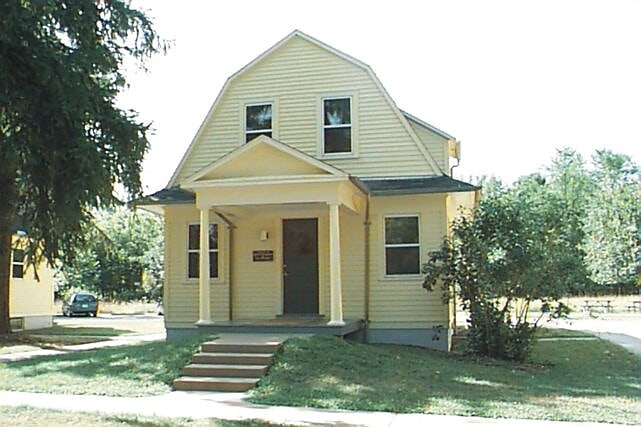
The Jaite Mill Historic District, also known as Jaite, is a nationally recognized historic district in Cuyahoga and Summit counties in the U.S. state of Ohio. The Cuyahoga County portion of the district is located in the city of Brecksville, while the Summit County portion is located in Sagamore Hills Township. Built in 1903 as the Jaite Company Paper Mill, its center is at the intersection of Vaughn and Riverview roads, north of the crossing of Interstates 80 and 271.
On May 21, 1979, the former company town was added to the National Register of Historic Places. Today it is the trailhead of several hiking routes in the Cuyahoga Valley National Park, and is on the way to the Boston Mills and Brandywine ski resorts.[7]
Jim Brown House

The Jim Brown House, also known as the Brown-Bender House, sits east of Ira and Akron-Peninsula Roads in Peninsula, Ohio, United States. Constructed in 1840, it sits back off the road, up a hidden, winding and steep driveway. The house is a four over four Greek Revival House. This simply means the layout of the house has four rooms over four rooms. This style of house was popular in the 19th century in America as the country greatly identified with Greek philosophy and politics. The house is white, supposedly resembling the great marble architecture of Greece. Also typical of this style, the roof has a lower pitch and the entrance door is framed with wide trim. The two story house has a commanding presence, sitting upon a hill with two chimneys and nine windows with green shudders.
The land also includes several over buildings. The big raised bank barn was built in 1886. This barn, the house, and Jim Brown's grave marker have all been listed in the National Register of Historic Places. A greenhouse that was built in 1930 is located approximately one hundred feet south of the house. A small part of the farmstead is the orchard. There are a variety of fruit trees and grapevines in this small area. Thirty-five acres of farmland are also included in the property. Most of this acreage is located west of Akron-Peninsula Road. This land lies in the Cuyahoga flood plain since the river flows through a section of the land. It has been flooded numerous times. The house has not been affected by flooding since it sits a lot higher than the fields.[8]
Everett Historic District
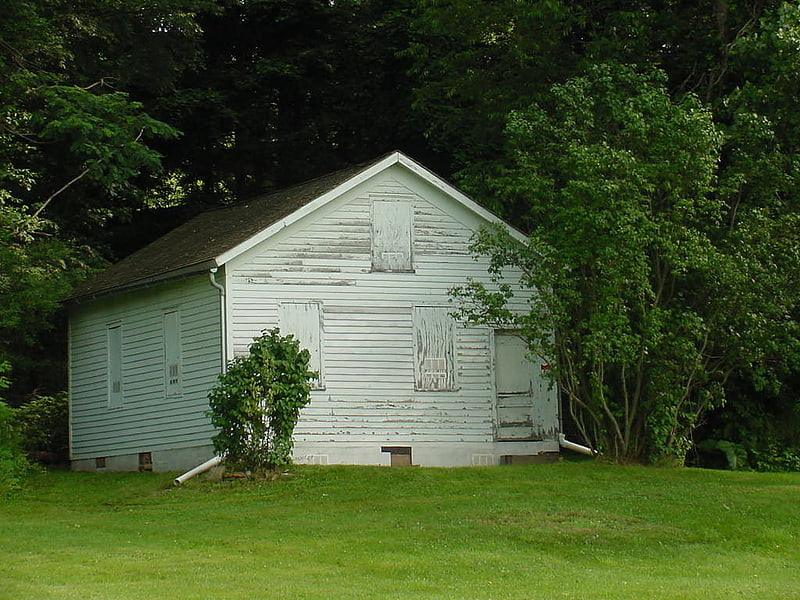
Everett Historic District is a rural village located within Cuyahoga Valley National Park. It is registered on the National Register of Historic Places. Everett is unique for being uncompromised by the pressures of suburban development. It represents a typical unincorporated hamlet of the turn of the 20th century rural America.
The historic district comprises the village buildings, dating from the 1880s to the 1930s, along with their outbuildings (a varied collection of outhouses, garages, chicken coops, barns, and a milk house. Everett formed due to the existence of Johnny Cake Lock on the Ohio and Erie Canal. The settlement was renamed Unionville, and still later Everett in honor of Sylvester T. Everett, the Valley Railway's vice president and treasurer.
The district overlaps part of the Everett Knoll Complex, an archeological district associated with the prehistoric Hopewell culture. This area was also used by the Civilian Conservation Corp for a nursery that played a key role in the development of the state and metropolitan parks in the area.[9]
Edmund Gleason Farm

Building in Valley View. The Edmund Gleason Farm is a historic district in Valley View, Ohio, United States. The core house was built in 1851 and was listed on the National Register of Historic Places in 1978 along with another building, on a 2-acre property. The historic designation was expanded in 1993 to add 13 acres including a dairy barn. In the twentieth century, the property became part of the Cuyahoga Valley National Park.
Gleason's house is a sandstone structure built into a hillside near the main line of the Ohio and Erie Canal. Its plan is that of a simple rectangle, divided into two bays on the ends and five on the front and rear, with the main entrance in the middle bay of the facade. The ends rise to gables, and elements such as gable returns and an undecorated frieze produce a Greek Revival appearance. The original structure was modified circa 1880, when a shed-roofed wooden porch was constructed; it bears its own ornamentation, including a bracketed frieze and a spindled railing.
Gleason and his wife Charlotte settled in present-day Valley View in an unknown year, although his first appearance in the tax records dates from 1843. According to the 1850 census, Gleason was a native of New York, and at the time of the census, he was engaged in farming.[10]